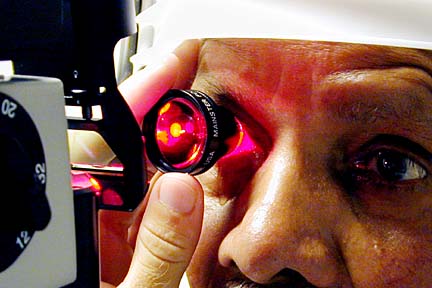Advertisement - Click to support our sponsors.


Laser lifts artist
By Helen Altonn
out of darkness
Star-BulletinFamed India artist Indra Sharma was in Bombay's airport last Dec. 25 headed for Calcutta to work on a book of 300 of his best paintings when his vision blurred.
It was the start of macular degeneration, plunging him into increasing darkness.
"Every month my vision was going down, down, down," he said, explaining he couldn't see, write or paint.
It will be "God's gift" if a recent treatment at Kapiolani Medical Center at Pali Momi lets him resume painting, said Sharma, 77.
He said his first project will be a portrait of his 2-year-old grandson, Shantanu Brownstein, on Kauai.
Sharma was one of the first patients treated with Visudyne Therapy for macular degeneration, after clinical trials ended at the Pali Momi hospital.

The U.S. Food and Drug Administration approved the treatment April 12. It is the first therapy for the wet form of macular degeneration, an age-related eye condition.Yellow deposits on the retina characterize the dry form of the disease. The wet form occurs when abnormal blood vessels grow in the back of the eye under the central vision area, the macula. Vision is distorted and dark spots occur in the center of the eye.
Drs. Gregg Kokame and Michael Bennett of Retina Consultants of Hawaii at Pali Momi participated in the third phase of clinical trials on the drug therapy.
Bennett, who performed the quick and painless procedure on Sharma, was at Emory University in Atlanta for the first two trial phases. He came here to open a practice and work with Kokame on the third phase. He said 30 patients were treated in the studies and at least 30 others are waiting for treatment now that it's available to the public.
About 100,000 to 200,000 Americans over age 65 develop macular degeneration -- the most common cause of blindness in the nation.
"Most get it because of ultraviolet exposure over a lifetime. Baby boomers, including myself growing up in Florida, never thought of sunglasses."
The treatment involves a photoactive or light-activated drug (Visudyne) and a nonthermal laser. The cool laser interacts with the drug to seal the leaking blood vessels without damaging the normal retina.
The procedure takes less than 20 minutes -- 10 minutes to inject the photosensitizing dye into a patient's arm; five minutes to clear the line, then 83 seconds for a laser at the retina to activate the drug.
The treatment isn't designed to restore vision although some patients have had dramatic visual improvement, Bennett said. It salvages vision rather than lets it spiral rapidly downhill to ultimate blindness, he said.
Bennett pointed to the great benefits to older people -- "a chance to see a grandchild's face again, to walk down stairs, to see things out there a little bit longer or a little bit better ... to handle independence."
Bennett said some patients need only one treatment while others may need three or four over about a year. "Everybody is variable ...
"The problem is, the majority of patients don't come in until it's too late ... Everybody says, 'Gee, there is no cure,' and they sit there losing their vision."
Medicare, the Hawaii Medical Service Association and other insurance plans don't yet include the procedure, which costs about $3,000 for the hospital and $900 for the physician, Bennett said. But the surgeons are billing the health programs in anticipation that they will soon cover it.
Sharma and his wife, Saraswati, are staying with their daughter, Nutan Brownstein, and family on Kauai for three months during his recovery. He'll return to Pali Momi in a month for a checkup.
Sharma lost sight in one eye about five years ago because of "wrong treatment" for an infection. So, the treatment for his remaining eye is "for my life," he said. The prolific and eminent artist has painted since age 13, often working from 6 a.m. to midnight to depict deities, saints and heroes in oil and watercolor. He is writing a book, "Prayer Through Painting."
"I love painting so much, it's like meditation," he said.